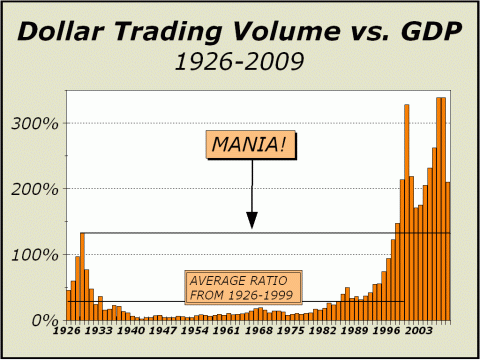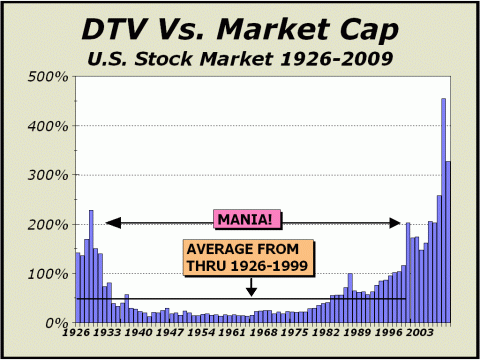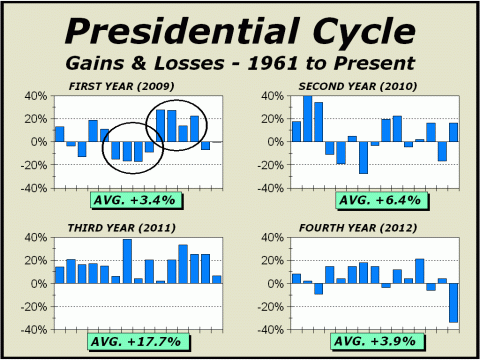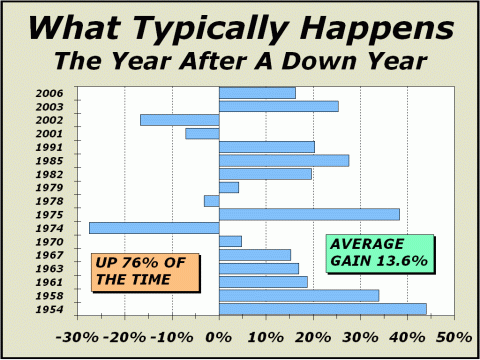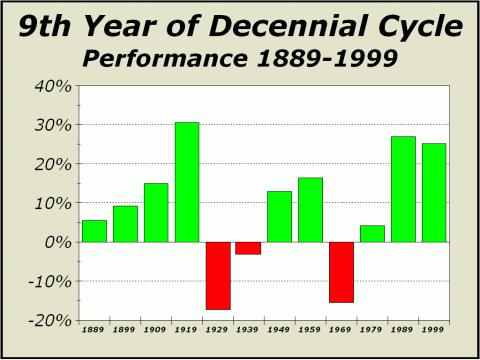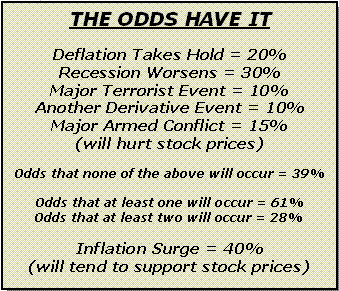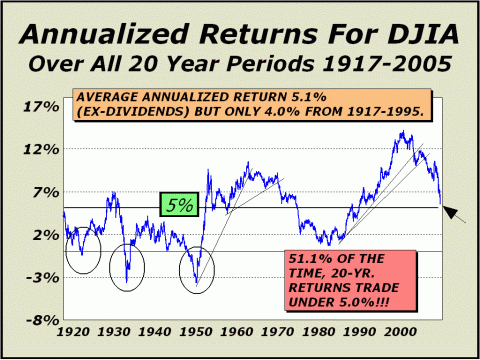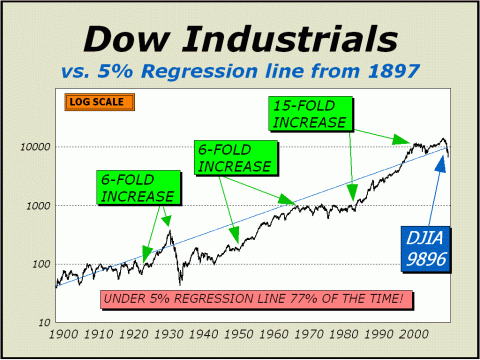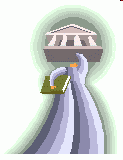
|
- THE GREATEST STOCK MARKET MANIA
OF ALL TIME -
DATED MARCH 15, 2009 A SPECIAL REPORT BY ALAN M. NEWMAN, EDITOR CROSSCURRENTS This feature is now published on roughly a quarterly basis. Our next update will likely be published in late June 2009. |
|
Our readership
continues to grow even as the worst bear market in nearly 80 years rages
on.
A world map of readers from 172 countries can be viewed HERE. Run your mouse over each country! This report
is primarily a compilation of articles that have previously appeared in
the Crosscurrents newsletter.
Please check out the testimonials on our Kudos page. Printable
files of this report are available only to paid subscribers. If you
are interested, please CLICK
HERE
After the crash of 1987, when Crosscurrents was only an internal communique distributed in a medium size brokerage, your Editor first discussed derivatives and the potential harm that was certain to occur. The analogy best utilized to describe the effects of unforeseen conseuqences were that of a black hole, sucking everything into it, an abyss from which there would be no escape. The analogy has worked quite well. In the fall of 1998, we were probably no more than a few hours from a total financial collapse when the country's largest banks and brokers were brought to the table by Alan Greenspan and the Federal Reserve. The assembled were told they would not be able to leave the room before a deal was made to rescue Long Term Capital Management and the system with it. Had the "deal" failed, the odds greatly favored that our entire financial structure would have collapsed. The rescue was successful. This time around, instead of $33 trillion in derivatives, there were well over $150 trillion and that did not include any of the financial constructs that were in the portfolios of non-U.S. banks and brokers. At their peak, estimates for notional values in derivatives worldwide ran as high as $400 trillion. The number staggers the imagination. In 1998, LTCM had an impact on a daisy chain of derivatives that was actually $2 trillion long. This is only a guess, but in 2008, the impact of Lehman Bros. was probably ten times as large. How else might the implosion of Lehman Bros. have resulted in the sequence of events that leave us where we are today? The events of the last six months were inevitable. The Dow closed at 11,143.14 on Friday, September 26, 2008. That weekend, we published the September 29, 2008 issue of Crosscurrents. Our lead article was called "The Inevitable Dénouement," a discussion of the consequences of the mess derivatives had created. The Dow was down 777 points the next day, the worst daily point loss in history and fell 40% in five-and-a-half months! The article was reprinted on these pages in the December 9, 2008 update of Pictures of a Stock Market Mania and can now be found in our archives at http://www.cross-currents.net/archives/dec08.htm. Another update was published for paid subscribers in the February 16th issue of Crosscurrents.
We are constantly amazed by the statistics. Clearly, for many decades, 1929 had been a year like no other, the mania to end all manias. However, by 1998, Dollar Trading Volume (DTV) began spiraling upwards at a dizzying rate. Within two years, DTV had ballooned almost two-and-a-half fold. Then, after the crushing bear market of 2000-2003, DTV once again erupted and finished 2008 at another record that equated to nearly 339% of the nation's gross domestic product. For every $1 spent on goods and services that drove the economy, $3.39 were spent on stocks of all stripes and Exchange Traded Funds (ETFs). Near the bottom of our chart, we have placed a line representing the average for DTV vs. GDP from 1926 through 1999. Thus, we have included 1929 and the years 1998 and 1999, also in manic territory. Even so, the average ratio was only 28.7%. The average was exceeded more than ten-fold in 2000, 2007 and 2008. If there was any doubt at all about both the bubble in 2000 and the echo of the bubble in 2007-2008, this chart alone should suffice to dispel all questions and act as evidence of a veritable mania.
In 2000, the increase in DTV amounted to almost the entire total of DTV in 1998. In 2007, the increase in DTV amounted to more than total DTV in 1997. Relative to GDP, activity in
2008 was more than 43 times
Greed won. You lose. The stock market crash of 2008-2009 has meant a far lower denominator for the equation represented in the chart below (DTV/total stock market capitalization). This created a situation where the indicator rocketed to an absurd extreme last year, but now, as the rate of trading has subsided, our indicator has fallen considerably. Even so, the 2009 rate of 327% remains higher than any year except 2008 and is far higher than at the manic top of 1929. We can only wonder at one point will the indicators illustrate a rational stock market capable of a new bull phase? Clearly, there is little likelihood that the same kind of frenetic and manic activity that drove prices to extremes in 2000 and then again in 2008 is not going to be possible again for generations to come. However, a return to historic norms also appears to be out of the question. The world just does not work that way anymore. Technology and a renewed cycle of growth will probably be accompanied by heavy activity, but at what levels? Given the overvaluations that had to occur with the manic levels we see in our charts above and below, activity will almost certainly continue to subside for the foreseeable future. By the autumn of 2010, when we expect the possibility of an end to the bear market, we believe DTV versus GDP will likely fall to as low as 150%. DTV versus Market Capitalization will probably fall to 200%. Of course, these are only guesstimates, but they at least afford a framework to formulate some ideas about how the future will play out.
For the meantime, the statistics are still way out of whack. Greed Won. You Lose.
The following article was the
lead article in our Year Ahead January 5, 2009 issue.
The Year Ahead: The Odds Improve, Risk Does Not In 44 years of observing the markets, this writer has never seen a year poised for such diametrical extremes. On the one hand, the federal government is fully embracing a position of supporting the economy. A bailout of the banking and auto industries will undoubtedly be followed by a huge stimulus for consumers. For the first time in decades, as measured by Tobin’s Q ratio, stocks are cheap. Plus, given the steady pumping of money into the financial system, a resurgence of inflation should tend to keep stocks at least on an even keel. On the other hand, the federal deficit will soon balloon to well over $1 trillion and if logic prevails, the dollar will tank, leaving no rationale for foreign money to remain in U.S. paper, either stocks or bonds. Despite a sizeable stimulus, the consumer remains an enormous question mark. And what of the commercial mortgage market? Or credit card debt? There are still too many factors with attendant potential for blowups and the risk of deflation remains if the economy recedes further into the abyss. Make no mistake, the year ahead will prove enigmatic until we finally begin to see some of the results in the rear view mirror. While we intend to make a very good case for vastly improved odds for stocks, we cannot avoid the many reasons that keep risk very much in our view. Below, the first year of the Presidential Cycle is no barn burner and as history has shown, is actually the worst performing year of the cycle. Clearly, President-elect Obama and his entire administration will have their hands full in the attempt to turn the economy around from its present state of woeful torpidity.
At first glance, all the chart seems to reveal is volatility, several big downers followed by several nice cycle years on the upside. What do we make of this? Unfortunately, the two circled areas are two very distinct phases; the first encompasses a secular bear market (1969, 1973, 1977, 1981) and the second encompasses a secular bull market (1985, 1989, 1993, 1997). As is evident, it’s a whole different ball game, depending upon whether one is rejoicing the bull or bemoaning the bear. Our take is solidly in the secular bear camp, despite the obvious improvements vis-à-vis valuations, including dividend yields at their highest in 18 years. About the only positive inference from this chart is this; since we measure the secular trend from March 2000, we are now completing the ninth year of the bear. It is likely late in the game for the bear market and 2009 looks to resemble 1981’s somewhat milder downside of 9.2%, rather than any of the preceding three cycle downsides averaging a substantially more hurtful -16.4%. The most encouraging statistic is visible in our next chart below. When you take a close look at the Dow’s annual closes, down years are typically followed by up years. Since 1924, there have been 27 years of downside and 18 were followed by upsides, averaging +7.8% in the process. Pretty good! In the modern era since 1950, it gets much better; the 17 down years were followed by upside 13 times, averaging 13.6%.
Thus, again, we have very conflicting parameters and as the very first sentence of this issue suggests, 2009 is a year poised for diametrical extremes. Additional evidence is also conflicting. Statistically, the Decennial Cycle works in favor of stocks (see next chart below) but we erred this past year by placing too much faith in the cycle and we’re cautioned by the experience. Thus, despite the fact that nine of the last dozen years ending in “9” were up, averaging gains of 8.5%, we note with skepticism that the three down years of 1929, 1939 and 1969 all occurred in secular bear markets! Again, the secular bear cycle appears to trump the statistical evidence. Thus, despite the paucity of repeat down years, 2009 looks to repeat on the downside.
Our calculation of the odds confirms a better outlook than last year, but too much harm has already been done for a more positive view. The 30% odds we have accorded for a worsening recession is at least balanced by our 40% odds that the surge in money supply will be accompanied by a surge in inflation. Higher inflation will tend to support stock prices, while deflation, if it occurs, would have the opposite effect. In conclusion, the secular bear cycle still appears to trump the statistical evidence.
We’ll hope for the best, but 2009 looks to be down anywhere from nominally to at most 10%.
And now for the first time...a
little bonus for our visitors
The Crosscurrents Awards We bear in mind the ancient Chinese curse, “may you live in interesting times.” Now that 2008 has concluded, it is high time to present the 1st Annual Crosscurrents Awards for one of the most interesting years in stock market history, if not the worst year in any reader’s lifetime. No pedestals and no trophies here, just the scene as we see it. Rat Bastard of the Year The Rat Bastard of the Year award goes to none other than Bernard L. Madoff, who “made off” with as much as $50 billion of his clients’ hard earned cash. The size of this heist makes Ponzi look like a piker and worse yet, recent news suggests that Madoff’s greed has resulted in the loss of a human life. The mind fairly boggles at the scope of this enormous betrayal of trust. And just imagine, it took Bear Stearns, Lehman Bros., the worst recession in four decades, the worst volatility in seven decades and a lot more for the stuff to finally hit the fan. $50 billion?! Incredibly, the AP reported “The office for Bernard Madoff's sole auditor exudes anything but wealth and intrigue: It is next door to a pediatrician in a drab suburban building. The tiny storefront is discreetly labeled "Friehling & Horowitz" on its single glass door.” Folks, our grandchildren will be talking about this episode well after we return to dust. Well earned, Bernie. You are now the most reviled person of the twenty-first century. Posturing Pontificating Profusions Of the Year On several occasions in the latter part of the year, we have had the inglorious opportunity of witnessing a plethora of posturing pontificating profusions from the not so eminent domain of the combative constituent camps of the U.S. Congress and Senate. On September 29th, well after the Lehman bankruptcy threatened to rip apart the entire financial system, 95 Democratic and 134 Republican members of Congress voted “nay,” instead electing to have second thoughts the very next day when an all time record 777 point collapse in the Dow reminded our not so prescient pols that they too, have 401ks. We watched with subdued awe and increasing nausea as House Speaker Nancy Pelosi (Dem.) issued her partisan rebuttal of her Republican colleagues and then John Boehner’s (Rep.) claim that passage of the bill would have been possible if it had not been for Pelosi’s speech. It was just like being in high school again. Déjà vu. Thus, for their efforts to blame each other while the system tottered, we award the PPP to the entire Congress. Serious consideration was given to the U.S. Senate for their performance as auto industry bigwigs visited six weeks ago. While we also wonder why the auto chairmen flew to Washington in their own jets, the sport of trashing them seemed far more important to those on the panel than the problems that threatened perhaps two million jobs. In the end, the Senate took no action at all, leaving their largesse towards banks and brokers all the more puzzling. Schmuck of the Year In “The Joys of Yiddish,” Leo Rosten derives the Yiddish word “schmuck” from the Slovene word, šmok, meaning "a fool, an innocent, a gullible dolt." And so, with no further ado, we present our Schmuck of the Year Award to Christopher Cox, the proprietor of the SEC, a government agency whose mission statement solemly declares “The mission of the U.S. Securities and Exchange Commission is to protect investors, maintain fair, orderly, and efficient markets, and facilitate capital formation.” For starters, we’ll point out the curious coincidence that the Dow Industrials topped only three months after the Uptick rule was canned despite seven decades of utility. We will also point our finger at the ongoing saga of a broken short sales system and naked shorting that even the SEC has finally admitted can wreak havoc on fair and orderly markets and disrupt capital formation. A few months ago, we commented that Blue Nile (NILE) had more than three shares owned by large block holders for every share that was authorized to trade. Mr. Cox, we dare you to explain how that could possibly happen? And while you’re at it, please tell us how Bernie Madoff was able to pull the wool over your agency’s eyes for so long. Good riddance, Mr. Cox. Hero of the Year We present this award to you, the independent investor, who had to endure all of this crap. Happy New Year and may the future bring us all some sanity, some peace and a financial market we can trust.
The Long Term Prognosis Below, yet another perspective that illustrates the incredible magnitude of the super bull market and mania that ruled until the tech bubble collapsed after March 10, 2000. For decades, the typical assumption was that stocks can generate 5% annual returns ex-dividends. Clearly, our chart is evidence that from 1920 to the late 1980s, that was at the very least, a reasonable assumption. But on May 19, 1989, 20-year annualized returns surged above 5% and have yet to return to that level again. The 20-year annualized rate of return soared to as high as 14.2% in March 2000. There was no fair comparison to either the Roaring Twenties or the super post-WWII bull market. Even with the prospect of far lower dividends, any assumption that a 14.2% annualized return rate over 20 years could endure was simply idiotic. If returns for stocks could remain that high, they would place ALL OTHER ASSET CLASSES at a distinct disadvantage. If other asset classes could not compete, they could not possibly attract investors and would not survive. This was an impossible scenario and lasted as long as it did due solely to GREED.
Greed won. But in the end, as always, investors lose. The 5% Regression line for the Dow has become one of our favorite charts. It not only tells us the stories of prior super bull markets but shows us with astounding clarity the exact level at which we should reasonably expect the Dow to be trading over the course of time. The history of our indicator is 112 years, more than sufficient to formulate what an unsustainable level might be. The Dow has traded under the 5% Regression line fully 77% of the time, thus the 5% level should act, at the very least, as a caution for investors. For 65 years, the Dow traded BELOW the Regression line. We doubt that it will trade again under the line for another 65 years but clearly, it may be a good idea to assume the line now represents RESISTANCE.
The Dow touched the regression line precisely at the exact low in October of 2002. On October 7, 2008, the Dow
finally broke below the Regression line.
Old support has become new resistance. Greed won out for way too long. The old records are likely to last for a very long time to come.
To see a free sample copy of the Crosscurrents newsletter, CLICK HERE
In our last report, we estimated downside risk to Dow 6700, SPX 670 and Nasdaq Composite 1165. To date, the Dow's low close was 6547 on March 9th. On the same day, the SPX closed at 676 and Nasdaq at 1268. It is possible that the lows for year have already been seen. Upside potential
for the remainder of 2009 - odds 20%
Downside risk for
the remainder of 2009 - odds still relatively high at 40%
Volatility
should decline slowly over the next five months.
We still believe the bear market will not end before October 2010. THE CONTENTS OF THE ENTIRE WEBSITE ARE COPYRIGHT 2009 CROSSCURRENTS PUBLICATIONS, LLC I hope you have enjoyed your visit. Please return again and feel free to invite your friends to visit as well. Alan M. Newman, March 15, 2009 All information on this website is prepared from data obtained from sources believed reliable, but not guaranteed by us, and is not considered to be all inclusive. Any stocks, sectors or indexes mentioned on this page are not to be construed as buy, sell, hold or short recommendations. This report is for informational and entertainment purposes only. Persons affiliated with Crosscurrents Publications, LLC may be long or short the securities or related options or other derivative securities mentioned in this report. Our perspectives are subject to change without notice. We assume no responsibility or liability for the information contained in this report. No investment or trading advice whatsoever is implied by our commentary, coverage or charts. |
